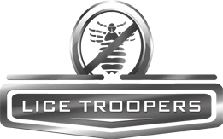We found an informative article online denoting how long head lice live and whether they can survive under various conditions. Lice Troopers lays this knowledge out for us.
Head lice are an invasive species that feed off of the human scalp, requiring our blood to survive. They drive parents crazy and frustrate all who deal with them. These parasites reside near the scalp, sometimes also turning up in our eyelashes and eyebrows. Let’s break down how lice survive, what their life cycle looks like, and how different environments affect their survival.
Head Lice Life Cycle
A head louse’s life cycle consists of 3 different stages.
1. The Nit stage – Lice start off as nits, or lice eggs. A nit attaches itself to your hair and is about a 1mm off-white fleck. Nits hatch after about 7- 10 days
2. The Nymph Stage – Nymphs are 1.1-1.3 mm long. They can be brown or white. In 7-9 days, they go through 3 nymphal or larval stages. Each happens after they feed & molt into their next form. Then, after this period of time, they develop into adults
3. The Adult Louse Stage – Adult lice generally feed off our blood about every 6 hours, though they can survive longer without feeding under certain circumstances. They grow up to 2mm long, and females grow larger than males.
5 Questions About Lice Lifespan and Survival
Lice Troopers answers 5 questions in their article about how long and under which conditions head lice can survive:
- How long do lice survive with their human host?
- How long do lice survive without their human host?
- Can lice survive in your home?
- Can lice survive under water?
- What do you do next?
- How long do lice survive with their human host?
Lice Troopers tells us that both nymphs and adult head lice require our blood to survive. They crawl on your hair with claws, and spread by crawling from one head to another. With a scalp to constantly feed on, they live about 30 days. They multiply quickly, however, as females lay up to 10 eggs per day. Lice Troopers warn us that this quick reproduction means a lice infestation won’t go away if it isn’t stopped.
- How long do lice survive without their human host?
Nits, nymphs, and adult lice all require a human scalp to survive, Lice Troopers tells us. IT’s not just about being able to feed… nits aren’t even born yet, so they can’t feed. It’s about having a warm and humid environment. Our comfy hair and the warmth emanating from our bodies provides an optimal habitat. Nits need this type of surrounding in order to properly intubate. So, in many cases, once they are expunged from our heads, nits can’t intubate properly. There is some danger however, as if they are in a similar environment with sufficient heat and humidity, they could intubate and hatch after a few days.
Adult lice and nits will usually die off within 24 hours with no food. So, unless they crawl onto a new host before then, they’ll likely die within a day or two. They can get into fabrics or fabric furniture for a similar environment and crawl onto a new host, however. This is where the danger lies.
- Can lice survive in your home?
As just mentioned, lice can pass onto clothing or furniture from your head. In such a circumstance, they survive for up to 24 hours. This poses a threat as it means any shared hats, headphones, couch cushions, fabric sofas, or bedding shared with another can result in lice transmission.
As for nits, if your home provides a sufficiently warm and humid environment, they could remain viable and hatch! So, even if 3 days have passed and no one new in your household has contracted lice, the possibility still exists! To prevent this, keep a cool, air conditioned home. And make sure to vacuum any possible surfaces onto which lice could have migrated or nits could have fallen.
- Can lice survive under water?
Lice Troopers tells us that lice can’t swim, so their chances of infesting another underwater does not increase. But, we know that lice don’t go away by washing our hair or taking a bath. So, what happens? Well, they survive by going into a state of suspended animation, in which they can remain for up to 8 hours!
To keep safe in the pool or at the beach, don’t bunch your items together, don’t pile your clothes together, and keep your own belongings away from those of your friends or family. And of cours, avoid sharing towels and head to head contact.
- What do you do next?
Lice troopers provides safe and effective treatments to get rid of lice and no longer have to worry! For families with multiple infestations, they recommend their home cleaning services to avoid new cases or any re-infestations. Stay lice-free!



